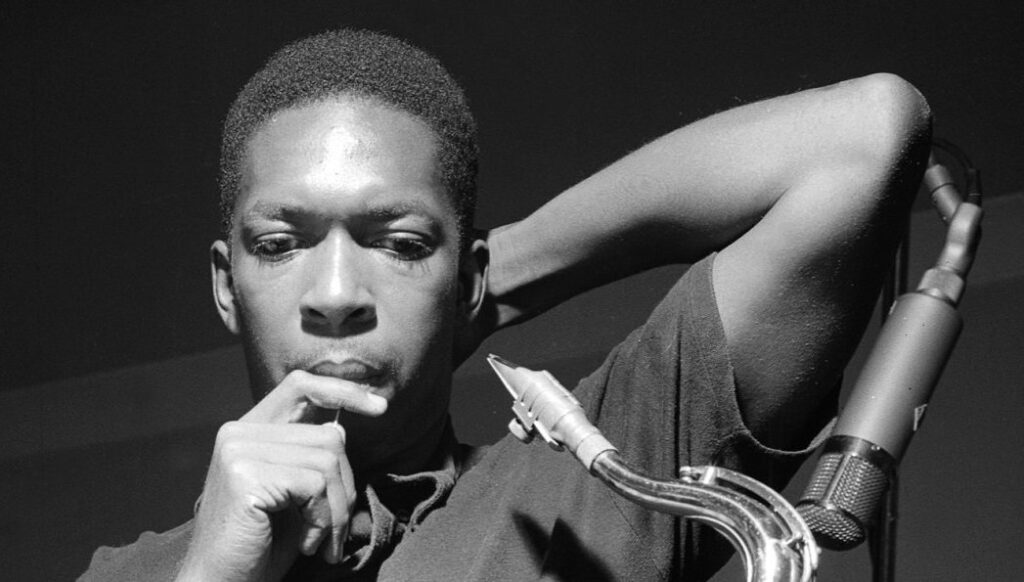JOHN COLTRANE
The Isolation Blues;
reflections during covid-19

During the year 1957 I experienced a spiritual awakening which was to lead me to a richer, fuller, more productive life. At that time, in gratitude, I humbly asked to be given the means and privilege to make others happy through music…May we never forget that in the sunshine of our lives, through the storm and after the rain – it is all with God – in all ways and forever. With love to all, I thank you.
– from the liner notes of “A Love Supreme” 1965
I want to be a force for real good. In other words, I know that there are bad forces, forces that bring suffering to others and misery to the world, but I want to be the opposite force. I want to be the force which is truly for the good…My music is the spiritual expression of what I am – my faith, my knowledge, my being…When you begin you begin to see the possibilities of music, you desire to do something really good for people, to help humanity free itself from its hangups…I want to speak to their souls.
– John Coltrane interview
Jazz speaks for life. The Blues tell the story of life’s difficulties, and if you think for a moment, you will realize that they take the hardest realities of life and put them into music, only to come out with some new hope or sense of triumph. Modern jazz has continued in this tradition, singing the songs of a more complicated urban existence. When life itself offers no order and meaning, the musician creates an order and meaning from the sounds of the earth which flow through his instrument. It is no wonder that so much of the search for identity among American Negroes was championed by Jazz musicians. Long before the modern essayists and scholars wrote of “racial identity” as a problem for a multi-racial world, musicians were returning to their roots to affirm that which was stirring within their souls.
– Martin Luther King, Jr. speech at the Berlin Jazz Festival, September 1964
*
My introduction to the world of jazz recordings and the jazz scene consisted of two names; Miles and Coltrane (all the rest are footnotes, so they say…). I purchased Miles Davis’ “Birth of the Cool” and John Coltrane’s “Giant Steps” and the rest has been a long jazz groove of vinyl, compact discs and mp3s. Netflix is currently streaming documentaries of both musicians and each film is a great view during this time of forced isolation and quarantine karaoke. I mentioned the PBS documentary about Miles Davis “Birth of the Cool” a couple of weeks ago and “Chasing Trane” is a 2017 film produced by John Scheinfield and stars Denzel Washington as the narrator of Coltrane’s writings. Since Coltrane was a member of the Miles Davis Quintet (twice!) the two films overlap material and are a good companion set showing how each musician challenged the other to innovate and push the jazz envelope.
John Coltrane’s music is inspirational; a bringing together of spirit, intellect, music, politics and love to model a life of integrity and art in modern society. Coltrane was influenced by the work of Martin Luther King, Jr. and was likewise active in the civil rights and peace movement of the turbulent sixties. One of Coltrane’s classics, “Alabama” was written just after the Birmingham church bombing in 1963 based on the cadences of MLK’s eulogy at the four girls’ funeral. Sometimes we don’t have words for our grief, fear and anxiety – that’s when the wail of a saxophone or the crisp beat of the snare best expresses our soul. During times of national and personal crisis circumstances do one of two things; they bring out the worst in people or they bring out the best. During the current COVID-19 pandemic the news headlines have been both dreadful and uplifting. We are seeing the best and the worst aspects of ourselves playing out. The pure tone of Coltrane’s saxophone matches the sincere heart of a man who is hoping for the best in all of us. Every time I see an act of kindness or creativity during these unprecedented times I am hopeful and encouraged to do the same. This is no time for unregulated negativity or pessimism. It is a time for the blues to keep our soul true and loving. The documentary also makes great use of never-seen-before concert footage and home movies. The closing scene of the film shows Coltrane in his backyard smiling and bowing to the camera man making a magnanimous gesture to the viewer. All is good in the world. We can get through this.
In the woods,
Dave
Books on Coltrane:
John Coltrane; Story of a SoundBen Ratliff
John Coltrane; His Life and MusicLewis Porrter
- “. . . the definitive Coltrane study (Porter), detailing his story as never before.”
—jazzcentralstation.com
April 14, 2020
